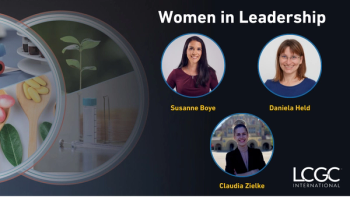
Optimizing Wastewater Treatment for Emerging Micropollutants Using Electrochemical Advanced Oxidation Processes and UHPLC–HRMS
Nadia Gadi and Allisson Barros de Souza spoke to LCGC International about their investigation into the application of electrochemical advanced oxidation processes (eAOPs) for the efficient removal of pharmaceutical residues in wastewater.
The persistence of pharmaceutical residues in municipal wastewater poses significant environmental and public health risks. LCGC International spoke to Nadia Gadi and Allisson Barros de Souza about their investigation into the application of electrochemical advanced oxidation processes (eAOPs) for the efficient removal of these contaminants. By integrating solid-phase extraction (SPE) with ultrahigh-performance liquid chromatography–high-resolution mass spectrometry (UHPLC–HRMS), they identified 24 pharmaceutical compounds in effluents, with 10 confirmed via reference standards, demonstrating eAOPs’ potential as a solution for mitigating micropollutant contamination.
You recently published a paper on the occurrence and elimination of pharmaceutical residues in municipal wastewater effluent by electrochemical anodic oxidation (1). How did this project arise?
NG: The need to address pharmaceutical contaminants in wastewater is a growing concern, given the persistence of these substances in aquatic environments. This project arose from the recognition that current wastewater treatment processes are insufficient to remove pharmaceutical residues effectively, which can harm ecosystems and public health.
Why are electrochemical advanced oxidation processes (eAOPs) used in water treatment, and why is this approach important?
Gadi: Electrochemical advanced oxidation processes (eAOPs) are utilized because they generate highly reactive hydroxyl radicals capable of removing a wide range of organic pollutants, including pharmaceutical residues and many other persistent pollutants. This makes them particularly useful for treating effluents that are otherwise challenging to treat using conventional methods, such as biological or chemical treatments, for example, flocculation coagulation.
What are the main limitations of eAOPs in practical applications for treating real effluents?
Gadi: While eAOPs show promise, several challenges remain in their practical application. These include the high cost of energy, limited scalability for large-scale industrial applications, and the potential for the formation of unwanted by-products. In addition, controlling the process to prevent side reactions remains a critical concern. However, alternatives are being explored to overcome these challenges; for example, combined processes. eAOPs can be combined with other treatment methods to improve efficiency and overcome limitations. For example, integrating eAOPs with biological treatment helps break down persistent pollutants into smaller, more biodegradable compounds, making them easier to remove. Combining eAOPs with adsorption, such as activated carbon or resins, allows pollutants to be concentrated before degradation, reducing energy consumption. Similarly, using eAOPs alongside membrane processes such as ultrafiltration or reverse osmosis enhances pollutant removal while minimizing energy and chemical use. These combined approaches help optimize treatment performance while addressing the challenges of using eAOPs alone.
What micropollutants are you analyzing and why? How were they detected and identified?
Gadi: The focus is on pharmaceutical residues, which are widely recognized as emerging micropollutants. Specific compounds include antibiotics, hormones, or other pharmaceutical chemicals. Detection methods such as high-resolution mass spectrometry (HRMS) are highly effective in identifying and quantifying these trace pollutants in complex wastewater matrices.
Your team developed an SPE–UHPLC–HRMS method for this analysis. What does this method offer over alternative approaches?
Gadi: The combination of solid-phase extraction (SPE), ultrahigh-performance liquid chromatography (UHPLC), and HRMS offers high sensitivity, precision, and the ability to identify and quantify a wide variety of micropollutants in wastewater. This approach significantly improves traditional method results by enhancing both the separation and detection of complex compounds in effluent samples.
What challenges did you face applying the method to real wastewater effluent matrices and at realistic concentrations and how did you overcome them?
Gadi: Real wastewater often contains a complex mixture of organic and inorganic materials, which can interfere with the analysis of pharmaceutical residues. At realistic concentrations, it becomes challenging to isolate and quantify specific pollutants without the method being optimized for matrix effects. The team overcame this by refining the sample preparation process and employing sophisticated analytical techniques to minimize interference.
Barros de Souza: Given the complexity of wastewater effluents, a lack of sensitivity for the detection of micropollutants at ultra-low concentration levels and an insufficient chromatographic resolution were the main challenges when the analytical method was applied to analyze real wastewater matrices. To achieve the required detection limits (sub ng/L), UHPLC coupled to HRMS was employed. Ionization suppression was nevertheless frequently observed in the MS interface due to co-eluting species along with the analytes. To improve method sensitivity as well as reduce the matrix effects, an SPE procedure was developed and optimized for isolating the analytes of interest while removing matrix interferences. The optimized SPE–UHPLC–HRMS method was applied to identify 24 pharmaceuticals in the wastewater effluent. The identities of 10 of these compounds were confirmed by reference standards, and their accurate quantitation was performed using isotopically labelled standards, which achieved low ng/L levels.
What were your main findings?
Gadi: The study demonstrated the effectiveness of eAOPs in reducing pharmaceutical contaminants from wastewater. Key findings include optimal process conditions for maximum pollutant degradation, as well as insights into the types of compounds that are most effectively removed using this method.
How does this study contribute to advancing the real-world application of eAOPs in wastewater treatment?
Gadi: This study contributes to advancing the practical application of eAOPs by providing evidence of their efficacy in real-world wastewater scenarios. It shows that, with proper optimization, eAOPs could serve as a valuable tool for eliminating pharmaceutical residues, thus enhancing wastewater treatment technologies for broader environmental protection.
References
(1) Barros de Souza, A.; Gadi, N.; van de Goor, T.; et al. Occurrence and Elimination of Pharmaceutical Residues in Municipal Wastewater Effluent by Electrochemical Anodic Oxidation. JWPE 2024, 66, 105899. DOI: 10.1016/j.jwpe.2024.105899
Nadia Gadi is a process design engineer with a PhD in chemical engineering. Her research focused on electrochemical advanced oxidation processes and adsorption on activated carbon for micropollutant removal from water. She has experience in R&D and process design, developing innovative solutions for complex water treatment challenges. Her expertise includes MBR, CBAS, MBBR, UF, and RO system design. She has worked on projects of varying scales, combining technical knowledge with project management and problem-solving skills. She currently works as a process design engineer, specializing in advanced wastewater treatment solutions to support sustainable water management.
Allisson Barros de Souza is a chemist originally from Spain. He holds a PhD in pharmaceutical sciences from KU Leuven (Belgium). His doctoral research focused on the development of advanced analytical methods for the identification of micropollutants in environmental matrices. During his PhD, he developed several screening platforms based on (2D)-LC separations coupled with high-resolution mass spectrometers to support the design of novel (waste)water treatment technologies. He currently works as an analytical scientist in pharmaceutical manufacturing supporting the implementation of process analytical techniques (PAT) for real-time process monitoring.
Newsletter
Join the global community of analytical scientists who trust LCGC for insights on the latest techniques, trends, and expert solutions in chromatography.




